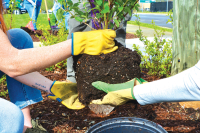Sylva woodworker goes back to the future
In our commodity-driven world, it may seem absurd to spend a year making a table. But for Sylva woodworker Brian Bartel, a year is just a fiber in the grand tapestry of tradition.
“My grandpa lived across the street from me growing up, and he taught me how to work hand tools,” Bartel said. “I was older before I realized what he’d done to me.”
Bartel recently completed work on a nine-foot long dining room table, its top a slab of three-inch thick black walnut. The project, which took more than a year to complete, was commissioned by Sylva part-time resident Sean Weaver and required milling more than 75 board feet of lumber to fine the choicest grain.
Weaver had a vision in his head of a dining room table that would serve as the focal point of his house. He didn’t want the piece to be something you could find anywhere else.
“I started asking around to a bunch of different woodworking people, and the fingers all started pointing at him as someone who could pull this off,” Weaver said.
Bartel, who moved to the mountains from Central Florida 12 years ago, has followed his own path to becoming a master craftsman.
Related Items
Having gotten his start woodworking through construction and remodeling jobs, he eventually began making furniture using recovered barn wood and featuring old designs that employed hand-cut joints.
Along the way, Bartel started buying old tools whenever he found them, assembling a collection of hundred-year old planes, chisels and saws that he outfitted in a custom cabinet complete with tiny toggles to keep them in place.
Weaver’s table assignment came along just as Bartel was looking for a challenge worthy of the name.
“This table right here is so far out of the realm of what I’ve ever done,” Bartel said. “It’s really pushed me. I’m pleased with it.”
The table’s top weighs more than 400 pounds and is adorned with hand-cut bow-tie inlays of white sycamore and African wenge wood. Ten metal screws affix the top to the base, and that is the only metal in the project. Every other attachment is functional joinery.
But the story of the table is not in its final design, its fancy adornments or its glossy finish.
“When I first met this table, I met it in the wood,” Bartel said.
Bartel and Weaver spent weeks looking for wood, before they settled on a massive black walnut tree that had been cut in a local yard and chopped into logs. The wood then had to be milled into slabs and studied for quality. Then it had to be kiln dried.
“There’s no drying schedule for wood that thick,” Bartel said.
Weaver and Bartel designed it together, using the vision of the patron and the know-how of the craftsman.
“You’re letting the wood be itself, but you’re conforming it to what you want,” Bartel said.
Bartel only uses Japanese planes because they cut so precisely, and he is as familiar with the philosophy of his art as its practice. He counts George Nakashima’s The Soul of a Tree and James Krenov’s A Cabinetmaker’s Notebook as parts of his toolkit.
To Bartel, wood is a living thing and woodworking is a live tradition, as evidenced by a restoration project he undertook recently for another customer.
Bartel was able to reliably date the antique as a 17th century relief-carving panel made of Honduran mahogany and fabricated in central Europe. That means the panel came from the New World to Spain on a ship and was sold to a merchant who moved the wood to the interior of the continent. Bartel’s first job was to take off the finish to see what he had.
“When I got the wash off of it I realize I was the first guy in 400 years to see this piece in that kind of detail,” Bartel said.
For Bartel, the connection to the past is not accidental.
“It’s like I could have been making my living like this 100 years ago and very little would have changed,” Bartel said.
But a year for a table can’t ever be considered typical. Bartel nearly lost his temper after he put a finish with too much talc on, layer after thin layer. The finish obscured the shine in the wood grain and he had to take it off.
“Right now I’m at that point. I’ve got blisters on my thumbs. I’ve sanded it a dozen times. Every aspect of the thing has to be perfect and over the course of a year, and it’s like...” Bartel stopped and shook his head.
But now the table is done, a work of art, the centerpiece of Weaver’s home. Weaver said he already has plans for more of Bartel’s furniture in his home. For Bartel, the market is telling him that in the end, people will pay for the winding road he has taken to his craft.
“It seems like value is coming back,” Bartel said. “People will spend money on something that will last forever.”
And now he has a piece of work that can stand the test of time with his own sign etched into the grain of the black walnut.
“As hard as this has been, it’s something I’ll remember the rest of my life,” Bartel said. “This process is still alive.”









